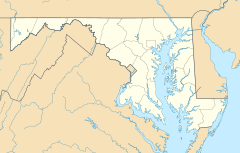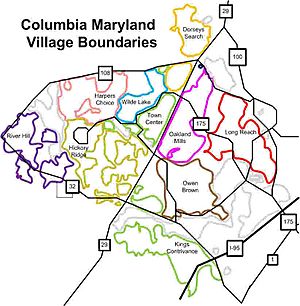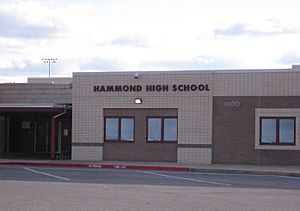Kings Contrivance, Columbia, Maryland facts for kids
Quick facts for kids
Kings Contrivance
|
|
|---|---|
|
Village
|
|
| Country | United States |
| State | Maryland |
| City | Columbia |
| Established | 1977 |
| Named for | The King's Contrivance restaurant |
Kings Contrivance is a village in Columbia, Maryland, USA. It is a part of a special type of city called a planned community. About 11,000 people live here.
Kings Contrivance is the village farthest south in Columbia. It was the eighth of Columbia's ten villages to be built. The village has three main areas: Macgill's Common, Huntington, and Dickinson. You can find different types of homes here, like houses, townhouses, and apartments. There's also a Village Center for shopping and fun.
Contents
What's in a Name?
The village got its name from a local restaurant. This restaurant was opened in 1962 by a person named Kingdon Gould, Jr.. He used an old family home for the restaurant.
Gould called his restaurant "The King's Contrivance." This name combined his nickname "King" with the word "contrivance." "Contrivance" was a word used long ago for old land grants, like "the owner's contrivance." In 1967, Gould sold the restaurant to the company that was building Columbia. In 1973, "Kings Contrivance" was chosen as the village name. People already knew the name and connected it to the area.
A Look at History
In the early 1960s, a developer named James W. Rouse wanted to build a new, well-planned city. His company bought over 14,000 acres of land in Howard County, Maryland. Rouse's company and another company formed The Howard Research and Development Corporation (HRD). Their goal was to create the new town of Columbia.
In October 1963, the plans for Columbia were shared with everyone. In 1965, the local government approved HRD's plan. This plan included a new type of zoning called "New Town zoning." This allowed for a lot of flexibility in how Columbia would be built.
In November 1973, HRD announced plans for Kings Contrivance. However, building the village was delayed because of a tough economic time in the mid-1970s. The first part of Kings Contrivance, called Macgill's Common, finally opened in 1977.
Most of Macgill's Common and Dickinson neighborhoods are on land bought from Kingdon Gould in 1963. This land was part of the original Columbia plan. Most of the Huntington neighborhood land was bought later, in 1971. It was added to the Columbia plan in 1976.
Macgill's Common opened in 1977. Huntington followed in 1979, and Dickinson opened in 1982.
In 1999, HRD wanted to add another large piece of land, called Emerson, to Kings Contrivance. This land was about two miles away from the village. Some people thought it was too far away. They worried it would cost the Columbia Association too much money to add things like pools and paths. Others thought it would bring more money to the association in the long run. In 2000, the Columbia Council voted against adding Emerson to Kings Contrivance. Emerson was then developed as its own separate area.
Neighborhoods to Explore
Kings Contrivance has three main neighborhoods, each with its own story.
Macgill's Common
Macgill's Common was the first neighborhood in Kings Contrivance. It is bordered by Route 32 to the south and Route 29 to the west. The Little Patuxent River runs along its eastern side.
When first planned in 1973, this area was called Macgill's Range. It was supposed to have homes and a large golf course. The golf course was meant to help the Columbia Association earn money. But due to the economic slowdown, the golf course was never built.
Work on Macgill's Common began in October 1976. It officially opened on June 25, 1977. In 2010, about 2,603 people lived here.
Much of Macgill's Common is on land that was once called Athol. This land belonged to Reverend James Macgill in 1732. The village gets its name from him. The street names in Macgill's Common come from the Folk Songs of North America collection by Alan Lomax.
Huntington
Huntington is located between the Little Patuxent River to the north and the Middle Patuxent River to the south. Part of it, called Huntington East, is about a mile away.
In the 1960s, a company tried to get permission to open a large stone quarry in this area. Many people, including James Rouse and Kingdon Gould, were against it. They worried about the noise and impact on the area. County officials denied the quarry requests.
In 1971, HRD bought the land. They even considered selling it to Marriott Corporation to build a huge theme park called "Marriott's Great America." The park would have had thrill rides, a marine life park, and an animal preserve. Many people supported it for jobs and fun, but others worried about traffic and pollution. In 1972, the County Council said no to the theme park. So, the land sale to Marriott never happened.
In 1973, HRD decided to add Huntington to Columbia as part of Kings Contrivance. After several years of discussions, this was approved in December 1976.
Huntington homes went on sale on June 1, 1979. When it was built, Huntington had the most open space of any Columbia neighborhood. About 330 of its 613 acres were kept as open land and woods. In 2010, Huntington had 3,202 residents.
The street names in Huntington mostly come from the works of poet Carl Sandburg. Some also come from poems by Emily Dickinson and Walt Whitman.
Dickinson
Dickinson is south of Route 32. It is bordered by Broken Land Parkway and Huntington to the east, and the Middle Patuxent River to the south.
Dickinson opened on September 25, 1982. This neighborhood is named after the famous American poet, Emily Dickinson. Its street names are taken from her poems. In 2010, Dickinson had a population of 5,523 people.
Long ago, a road called Kindler Road ran through what is now Dickinson. It crossed the Middle Patuxent River over a bridge. But the bridge was washed away during a big storm in 1972 and was never replaced. You can still see parts of the old bridge today.
Village Center
The Kings Contrivance Village Center is in the Dickinson neighborhood. It's a place where people can shop and gather.
The Village Center opened on June 14, 1986. It has changed over the years. A new Harris Teeter supermarket, which is a large grocery store, opened there in May 2008. The Amherst House, where the Kings Contrivance Community Association is located, is also in the village center. This building is named after Emily Dickinson's hometown in Massachusetts. It's also a place where people can rent space for community events and parties.
Parks and Fun
Each of the three neighborhoods in Kings Contrivance has its own community swimming pool. These pools are run by the Columbia Association.
There are many beautiful trails that wind through and around Kings Contrivance. These trails connect to Columbia's large system of bike and hiking paths. They also lead to County parks. The Patuxent Branch Trail runs along the Little Patuxent River. It connects Huntington and Macgill's Common to Lake Elkhorn. In the Dickinson neighborhood, there are paths along the Middle Patuxent River. These are part of the Gorman Stream Valley Natural Resource Area.
Parks in and near Kings Contrivance include Gorman Park, Huntington Neighborhood Park, and Savage Park. Howard County Recreation and Parks maintains all of these parks.
Schools in the Area
The public schools that serve Kings Contrivance are part of the Howard County Public Schools system.
- Elementary Schools
- Atholton Elementary School
- Bollman Bridge Elementary
- Forest Ridge Elementary
- Guilford Elementary
- Hammond Elementary
- Middle Schools
- Patuxent Valley Middle
- Hammond Middle
- Murray Hill Middle
- High School
- Hammond High School
Other Interesting Facts
In 1992, the South Columbia Baptist Church was built near Hammond High School. Before it was built, a historic stone home from 1846, called "Moundland," was taken down. Some of the stone from Moundland was used to renovate another home in Wilde Lake. This renovation was even shown on a TV show called "Dream House."
Parts of the movie Roulette (2013) were filmed at the Kings Contrivance restaurant.





